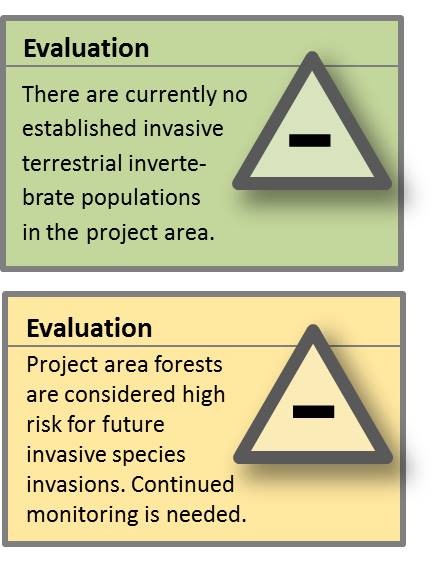Although no invasive terrestrial invertebrate populations are currently established in the project area, experts have identified the forests of western Oregon as a high risk ecosystem for invasion; continued monitoring is needed.
Invasive terrestrial invertebrates are potentially costly economic and ecological threats to the project area even beyond potential threats to locally harvested tree species.
What’s happening?
While many benign non-native terrestrial invertebrates (insects) are established in the project area, none are currently considered invasive; that is, no non-native insects are known to be responsible for local ecological or economic damage, or threaten human health. However, it’s important to note that the risk of future invasive insect introductions is very real. In part because, like any community, the Coos Bay area is exposed to invasive species introduction through any number of “vectors.” These include the transport of firewood, living plants, and freight packed wooden packaging material (see sidebar).
Due to the abundance of tree cover and the economic importance of the local timber industry, this section focuses on non-native wood boring insects that represent the largest potential economic and ecological threats to the project area. These species include the emerald ash borer (Argrilus planipennis), Asian long-horned beetle (Anoplophora glabripennis), gypsy moth (Lymantria dispar spp.), and balsam woolly adelgid (Adelges piceae)(Table 1). None of these species are
currently established in the project area. However, should they become established locally, they would pose significant threats.

Invasive insects can spread through a variety of mechanisms, including the long-distance transport of wooden goods, plants, or trees. For example, the interstate transportation of firewood and other wooden goods (e.g., patio furniture, pallets) can spread invasive wood-boring insects.
Similarly, the use of wooden packaging materials (e.g., crates, wood shavings, wooden supports) may encourage the spread of these same species. In addition to the transport of wooden goods, the spread of insects may be facilitated by the movement of ornamental plant species and nursery stock.
Source: USDA 2006, 2015; OSU 2011
The emerald ash borer, native to eastern Russia, northern China, Japan, and Korea (McCullough and Usborne 2011; OSU 2011), was first detected in Detroit, Michigan in 2002. Since detection, the emerald ash borer has spread gradually and is now found in 25 states and two Canadian provinces. The westerly extreme of its range has reached Colorado.
Although the emerald ash borer is not currently found in Oregon, experts
believe that the future introduction of this species could result in potentially tremendous economic and ecological costs (OSU 2011). Experts believe that the emerald ash borer was inadvertently introduced to North America when infested wood was used in crates or stabilizing cargo in ships (McCullough and Usborne 2011; Carlson and Verschoor 2006). Adult emerald ash borers deposits eggs in the crevices of true ash trees (i.e.,Fraxinus spp.).
After emergence, insect larvae damage or kill their host trees by consuming the tree’s cambium (i.e., layer of live inner bark), interrupting the flow of nutrients throughout the tree (Carlson and Verschoor 2006; OSU 2011).
Emerald ash borer damage has been extensive in the eastern United States. Kovacs and colleagues (2010) estimate that emerald ash borer infestations have caused approximately $10.7 billion in damage, resulting on the removal or replacement of approximately 17 million ash trees by 2019 in the Midwest, Mid-Atlantic, and Northeast states alone. In Oregon, the introduction of the emerald ash borer could jeopardize native populations of Oregon ash (Fraxinus latifolia), the only species of true ash that occurs in the project area (Pojar and MacKinnon 1994; OSU 2011).
Williams (pers. comm. 2015) explains that although the emerald ash borer does not target commercially harvested species, its introduction represents potentially substantial economic costs to the timber industry if introduction is accompanied by additional regulation (e.g., quarantine, mandatory inspection of mobile equipment such as trucks). He adds that the use of pesticides to control emerald ash borer infestations could also
potentially affect water quality. In addition to these possible costs, the introduction of the emerald ash borer to Oregon could also decrease habitat complexity by threatening the viability of Oregon ash populations in ecologically important areas (e.g., riparian zones) (OSU 2011).
Table 1. Summary of potential invasive insect threats to the lower Coos watershed.
Asian long-horned beetle deposits eggs in firewood. Photo: Environmental News
The Asian long-horned beetle, native to China and Korea (Haack et al. 2010), was likely first introduced to Brooklyn, New York in 1996. It has since spread to several eastern states, including New Jersey, Massachusetts, Ohio, and Illinois as well as Ontario, Canada. Although its spread has been contained to the eastern United States, experts suggest that an Asian long-horned beetle invasion of western Oregon forests would result in extensive ecological and economic damage (OSU 2011).
The Asian long-horned beetle was inadvertently introduced to the eastern United States in wood packing materials (Haack et al. 2010; OSU 2011). It damages hardwood tree species, including, but not limited to, maples
(Acer spp.), birch (Betula spp.), ash (Fraxinus
spp.), poplars (Populus spp.), willows (Sa lix spp.), and elm (Ulmus spp.)(Haack et al. 2010). Similar to other invasive wood boring species, Asian long-horned beetle larvae damage healthy trees by consuming their vascular tissues, resulting in structural weakness and tree death (OSU 2011; Haack et al. 2010). Since its introduction to North America, Asian long-horned beetle damage has been extensive and costly in the eastern United States. If allowed to proliferate, the estimated magnitude of nationwide damage is significant. According to Nowak et al. (2001), from 1997 to 2008, Asian long-horned beetle infestations caused $373 million of damage to forests in Illinois, Massachusetts, New Jersey, and New York alone. They estimate that Asian longhorned beetle infestations could cause a loss of 1.2 billion trees nationwide (valued at $669 billion) if the insects are allowed to continue spreading.
In Oregon, the potential ecological effects of Asian long-horned beetles are also significant. Although this species would not affect Oregon’s
dominant conifer species (e.g., Douglas fir, Port Orford cedar, hemlock), the insect is likely to infest native hardwood species (e.g., Oregon ash, big leaf maple, alder)(OSU 2011). These hardwood species provide important
ecosystem services, including nutrient cycling, erosion control, and habitat complexity. They add that Asian long-horned beetle infestations
could also result in significant economic costs where extensive beetle damage may necessitate the removal of large trees in urban settings (OSU 2011). Similar to the emerald ash borer, the Asian long-horned beetle may
also result in significant costs to the timber industry if infestation within or in proximity to the project area results in additional regulatory
measures (Williams pers. comm. 2015).
Figure 2. A delta trap, used to detect European and Asian gypsy moths, to facilitate early detection of these species. Source: ODA 2015.
The European gypsy moth was first introduced in the late 1860s, when the species was brought to Massachusetts from Europe for the purposes of silk production (USDA 2003b). Quickly realizing the alarming potential for damage, the Massachusetts State Board of Agriculture began attempts to eradicate European gypsy moths using methods that ranged from manual removal of egg masses to systematic forest burning and application of primitive pesticides (Figure 1) (USDA 2003b).
The United States Department of Agriculture (2008) explains that gypsy moths cause a substantial amount of damage by defoliating, weakening, and ultimately killing host trees, including broad-leafed hardwood species (i.e., oak, apple, alder, willow, birch, madrone, cottonwood) as well as coniferous species that are abundant and harvested commercially within the project area (i.e., Douglas fir, pine, and western hemlock) . They add that gypsy moth infestations reduce the forests’ ability to defend against disease, fire, and erosion, deteriorating the quality of habitat for other
forms of plant and animal life.
Figure 1. Two workers attempting eradicate European gypsy moth by burning the forest with kerosene (c. 1890). Photo: USDA 2003b
Despite early control efforts, the European gypsy moth continued to spread and established populations throughout New England by the 1920s (Sadof 2009). Attempts to eradicate European gypsy moths began again in the 1940s following the discovery of the use dichloro-diphenyl-tirchloroethane (DDT) as an extremely effective pesticide. But the application of DDT for pest control was limited in the 1960s and banned in the 1970s due to public concern about the severe environmental affects associated with DDT use (Sadof 2009). In the past 20 years, efforts to control European gypsy moths via the aerial application of alternative pesticides have once again been reestablished (Sadof 2009; USDA 2003a). European gypsy moth infestations remain a serious forest management issue throughout New England, the Mid-Atlantic, and the Midwest (ODA 2015).
Although isolated populations of European gypsy moths have occurred in Oregon since the 1970s (including seven moths found in Grants Pass in 2015) there are currently no established populations in the state. This is
in part due to Oregon’s early detection rapid response protocol, which include a large-scale trapping program throughout the state (Figure 2) (ODA 2015).
The Asian gypsy moth is similar to European gypsy moths in many ways, but Asian gypsy moths are known to feed on a wider range of host species and cover much larger distances in flight (USDA 2015).
Asian gypsy moths were first introduced to North America near the Port of Vancouver, British Columbia in 1991, likely from ships infested with egg masses arriving from eastern Russia.
Figure 3. Asian gypsy moth egg masses on the inside of a vehicle wheel. Photo: Australian Department of Agriculture 2015
Since its arrival, the Asian gypsy moth has spread to parts of the Pacific Northwest, including Washington and Oregon. A secondary inadvertent introduction (again from infested cargo ships) occurred on the east coast of North Carolina shortly thereafter (1993). Since then, Asian gypsy moths have been detected and largely eradicated on at least 20 separate occasions in locations across the United States. Though still intermittently detected in Oregon, local Asian gypsy moth eradication efforts have been successful thus far due to early detection and rapid response (USDA n.d., USDA 2015).
Beginning in 2009, the United States Department of Agriculture has taken preventative measures against the Asian gypsy moth by requiring foreign trading partners to participate in rigorous inspections of ships at the time of departure from foreign ports and again during entry at domestic ports. Although these preventative measures have been effective, Asian
gypsy moths continue to be detected periodically in the United States, spread by a variety of means (e.g., Figure 3)(USDA 2015).
Washington. While not yet detected in the project area, this insect does affect local tree species, including grand fir (Abies grandis) (USFS n.d.).
Balsam woolly adelgids affect true fir species by injecting a hormone into the host tree that disrupts normal growth and inhibits cone production.
Balsam woolly adelgid populations in the Willamette Valley have limited the reproductive success of grand fir (Abies grandis), and may ultimately cause the eventual disappearance of this species from Willamette
Valley ecosystems if current trends continue. The ability to control balsam woolly adelgid infestations by applying areal pesticides is limited due to the species’ ability to excrete a proactive waxy coating. Although alternative methods (e.g., treatment of individual trees) have proven effective, these methods require additional resources and are generally limited to accessible areas supporting high-value trees (USDA 2006).
